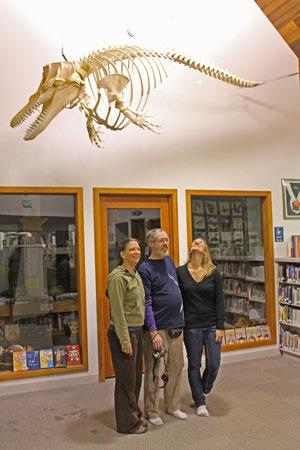In the summer of 2005 a killer whale calf was found dead in Glacier Bay National Park and Preserve, and the discovery led to an unusual opportunity. Very few complete killer whale skeletons are known to be on display anywhere in the country, and now, after an impressive cooperative effort, the articulated skeleton is available for public viewing near the park.
The story began on August 26, 2005, when the park staff learned that a juvenile female killer whale had become stranded and died on Young Island in lower Glacier Bay. Using the Serac, an NPS park vessel, the nearly twelve-foot long whale was carefully towed to the park headquarters area at Bartlett Cove. A thorough necropsy revealed that a halibut circle hook embedded in the whale's esophagus had caused the animal's death.
Park staff members recognized a unique interpretive opportunity, and so a group of local volunteers and park employees embarked on a project to clean and prepare the skeleton for articulation. An "articulated skeleton" is one which has been mounted with the various parts connected in such a way that it demonstrates the normal relationships existing in a living specimen.
This past winter, well-known Alaska articulation specialist Lee Post traveled to Glacier Bay to reassemble the bones into a beautiful skeletal exhibit. Post, who is from Homer, Alaska, has articulated over two dozen skeletons, and says Orca whale skeletons are very rare in collections. He believes there are fewer than eight complete examples of such skeletons on public display anywhere in the United States.
During his visit to Glacier Bay, Post spent most of his time in the Gustavus School woodshop, where he welcomed students, community members and volunteers to participate in all aspects of the project. While working on the skeleton, he frequently acknowledged the pristine condition of every bone'a testament to the careful cleaning and handling by park staff and community volunteers.
After two weeks of hard work by Post, the 12-foot-long, 75-pound reassembled skeleton was carried by hand from the woodshop to the Gustavus Community Library, where it was welcomed by "a fanfare of song and dance."
The park hosted an Open House on February 25, 2014, to celebrate the culmination of this nine-year project. The Glacier Bay interpretive division facilitated an evening of orca-themed events and presentations, and welcomed honored guests from the Hoonah Indian Association to perform a Tlingit blessing of the whale. A special name Keet'k', meaning "little killer whale," was given to commemorate the return of her Spirit.

Whale educators Melissa and Kelly, along with bone specialist Lee Post, admire the final display in the Gustavus Community Library. NPS photo.
According to a park spokesperson, "This beautiful display would not be possible without the support and hard work of many. Partners include Alaska Geographic, Gustavus School, Gustavus Community Library, and over sixty Gustavus community volunteers and friends. We're very proud of our rare killer whale calf."
"It seems very fitting that Keet'k' found her home in our local library, surrounded by a myriad of books that tell stories. She will tell her own special story for future generations, connecting community and visitors to the magic of Glacier Bay for years to come."
The park's visitor center occupies only a small area above the restaurant and lobby in the Glacier Bay Lodge, so the Gustavus library offers an excellent location for display of the skeleton. The public display in the library also allows a long-term opportunity for connections with the community and local school children.
Gustavus is a small (and in fact the only) community located just outside the park facilities at Bartlett Cove, and provides important services for both visitors and park employees.The public library is adjacent to the post office and a short stroll from the local airport, the point of entry and departure for almost all of the visitors who spend any time ashore in the park.
The Gustavus Community Library is open six days a week, Monday through Saturday. For daily hours of operation, call 907-697-2350.
You can learn more about Glacier Bay's orca articulation project here. You can also view "From Discovery to Display," a 15-minute montage of images and music highlighting the years of work and successful partnerships involved in this project, at this link.
Whales are a very big draw for visitors to Glacier Bay, and later this year, a second and even more impressive whale skeleton is scheduled to go on display in the park. This project has been underway since July 2001, when a 46-foot adult female humpback whale was found dead at the mouth of Glacier Bay after having been struck by a cruise ship.
Known as Whale #68, or SNOW, this humpback was a regular visitor to Glacier Bay and was observed each season between 1975 and 2001. The entire skeleton was collected, and over the intervening years many volunteers from the community, including high school and college students, have worked alongside Glacier Bay staff to retrieve, clean, and preserve the whale bones.
When completed, the outdoor exhibit in the parks' Bartlett Cove area will house the second largest rearticulated humpback whale skeleton on display in the world. We'll bring you an update on this project on the Traveler when it's ready for public viewing.
If you're looking for information to help plan a visit to Glacier Bay National Park and Preserve, you'll find plenty of details on the park website.




Comments
It is unfortunate that both whales were killed by interaction with humans, but it's a good thing that they have been turned into such amazing educational opportunities.